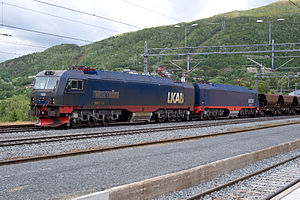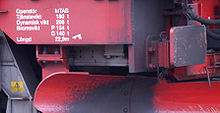MTAB IORE
| MTAB IORE / LKAB Malmtrafik AB IORE | |
|---|---|
|
IORE
|
|
| Numbering: | UIC no. : 91 74 0000 1XX-Y S-MTAB |
| Number: | 17 pairs |
| Manufacturer: | ADtranz , Bombardier Transportation |
| Year of construction (s): | 2000–2004, 2009–2010, 2013–2014 |
| Axis formula : | Co'Co '+ Co'Co' |
| Length over coupling: | 2 × 22,905 mm |
| Empty mass: | 2 × 180 t
2 × 150 t without counterweight |
| Wheel set mass : | 30 t
25 t without counterweight |
| Top speed: | 80 km / h |
| Continuous output : | 2 × 5400 kW |
| Starting tractive effort: | 2 × 700 kN |
| Power system : | 15 kV 16.7 Hz ~ |
The IORE are electric locomotives of Swedish Erzbahnverkehrsgesellschaft LKAB Malmtrafik AB , for the transport of heavy iron ore trains on the Iron Ore Line from the mines in Kiruna and Gällivare / Malmberget to the ports of Narvik in Norway and Lulea are used in Sweden. The name is derived from the English term iron ore for iron ore.
These double locomotives can pull 8,600-ton trains loaded with 6,880 tons of iron ore. The locomotives have an output of two times 5400 kW (two times 7342 hp). With a pulling force of twice 700 kN, they are among the most powerful electric locomotives in the world. The first double locomotive was put into service in 2000.
history
In 1994, MTAB , a subsidiary of the mine operator LKAB , ordered nine pairs of locomotives. They were developed by ADtranz in Oerlikon (Switzerland) and built in Kassel. The locomotives delivered from 2000 belong to the Octeon family of locomotives and were later temporarily referred to by Bombardier as the Traxx H 80 AC . If three of the twelve traction motors fail, you are still able to adhere to the timetables, which provide for a maximum speed of 60 km / h for loaded trains and 70 km / h for empty trains.
The original plan was to deliver all locomotives with a 30 t axle load and use them with the new ore wagons from South Africa. These wagons did not meet MTAB's expectations because, on the one hand, they were not able to cope with the climatic conditions and, on the other hand, the hopper for the iron ore pellets changed after the order was placed had too small a capacity. Thus, the other locomotives were initially procured with 25 t axle load and couplings for traffic with the old existing wagons and only later provided with ballast for 30 t axle load. The nine new locomotives should have replaced the old Dm3 locomotives, so they would have been scrapped. However, this was not possible because the output of the mine was massively increased due to the great demand for steel on the world market and the old locomotives therefore had to remain in use.
In August 2007, MTAB ordered four more pairs of locomotives from Bombardier Transportation , which were delivered in 2010. These locomotives were ordered for the expansion of the line to Narvik for 30 t axle load and the final replacement of the Dm3 locomotives and will be used together with new wagons procured on the Swedish market. The increasing production of the iron ore mine called for more locomotives, so that in 2011 another four pairs of locomotives were ordered, which were delivered from 2012 to 2014.
Because of their high weight, the locomotives were equipped with auxiliary bogies for transport from the Bombardier factory in Kassel, while the actual bogies were transported separately on heavy trucks. Parts that protrude beyond the G1 clearance profile and the ballast were only installed in Sweden.
After the delivery of the last IORE series, the Dm3 locomotives are only to be used in front of the olivine trains. This rock is transported from Narvik to Kiruna and required for the production of the pellets.
LKAB IORE
In 2012 the subsidiaries of LKAB were renamed. MTAB Malmtrafik i Kiruna AB was renamed LKAB Malmtrafik AB , under which the locomotives have been operated ever since.
technology
With a pulling force of 1400 kN (2 × 700 kN), the locomotives are considered to be the most powerful electric locomotives in the world. The double locomotives consist of two identical halves that, in contrast to the previous Dm3 series, can be separated outside of a workshop. They can therefore be used individually, which rarely occurs in practice.
Locomotive body
The 18 mm thick side walls together with the 25 mm thick end walls form a stiff welded construction, which is additionally reinforced by cast shock bars and cross members in the area of the secondary springs above the bogies and at the transformer.
The heavy steel construction enables the locomotive to exert great tractive forces and makes it robust enough to withstand high loads such as those that occur when driving in snowdrifts or when colliding with moose weighing up to 400 kg. The pulling force is additionally increased with ballast, which is arranged in the form of steel plates above the bogies. In addition to the 30 t in the locomotive body , two additional 3 t ballast parts are arranged in the underframe in front of and behind the transformer, so that it is also mechanically protected in the event of a collision.
Couplings
The locomotives are equipped with the Russian SA3 couplings , as they are also used on the other vehicles of the ore railway. The first locomotives, like the first wagons for 30 t axle load, were equipped with American AAR type F couplings. The locomotives with an axle load of 25 t were equipped with SA3 couplings from the start, which were retrofitted to the other locomotives. First the couplings on the front were replaced, then the couplings between the two locomotive halves.
There are also extendable, unsprung auxiliary buffers on the front, which allow broken-down trains to be pushed away with UIC pulling and pushing devices, for which a UIC auxiliary coupling is carried on every locomotive.
Drive and bogies
The locomotives are equipped with water-cooled GTO - power converters , the three-axle bogies with traction motors suspended driving. The design of the bogies is similar to the Blue Tiger diesel locomotive . There is a strong steel beam in front of the first axle in the bogie, which should prevent the locomotive from tipping over in the event of a derailment. For easier cornering, the center axle of the bogies can be moved 25 mm laterally.
The Automatic Train Control , which is used in Sweden and Norway, serves as the train control system. GSM-R two-way radios are built into the driver's cabs.
Facility
Due to the lonely location of the line and the extreme weather, the locomotives are equipped with special insulation as well as emergency heating and lighting. In the driver's cab of the locomotive there is also a hotplate, a refrigerator and a car radio with CD player. A toilet is available to the driver in the engine room.
commitment
On the route to Luleå, locomotives with a 30 t axle load and new ore wagons are used, while on the route to Narvik only those with 25 t axle load and old ore wagons were used. With the expansion of the line, all locomotives were converted to an axle load of 30 t.
Names
All 34 locomotive halves are named after locations along the route used by the iron ore trains. In the beginning, the successive numbers were always coupled with one another. As a result of repairs to individual halves or upgrades, they are now mostly assembled at random.
| number | Surname | number | Surname |
|---|---|---|---|
| 101 | Pole circles | 102 | Malmberget |
| 103 | Luleå | 104 | Gällivare |
| 105 | Narvik | 106 | Kiruna |
| 107 | Svappavaara | 108 | Torneträsk |
| 109 | Abisko | 110 | Björkliden |
| 111 | Katterat | 112 | Vassijaure |
| 113 | Bergfors | 114 | Rautas |
| 115 | Stake jaws | 116 | Stordals |
| 117 | ground | 118 | Murjek |
| 119 | Koskullskulle | 120 | Imperial Pacts |
| 121 | Rombak | 122 | Råtsi |
| 123 | Riksgränsen | 124 | Kaitum |
| 125 | Sjisjka | 126 | Sandskär |
| 127 | Bjørnfjell | 128 | Krokvik |
| 129 | Nattavaara | 130 | Mertainies |
| 131 | Straumsnes | 132 | Rensjön |
| 133 | Kopparåsen | 134 | Notviken |
literature
- Vaclav Dvoracek, Jan Olovsson: New locomotives for the ore line Lulea – Kiruna – Narvik . In: Swiss Railway Review. No. 3, 2001, ISSN 1022-7113 , pp. 116-121
Web links
- Lokguide E-Lok Iore at järnväg.net (Swedish)
- More information and pictures
- YouTube : IORE 115/117 and IORE 106/111 (LKAB, Sweden) : encounter of a moving ore train with a stopping one and approaching the second from a siding
Individual evidence
- ↑ Press release Bombardier (PDF file, 32 kB, Swedish)
- ^ Logistics. In: lkab.com. Archived from the original on May 31, 2012 ; accessed on April 4, 2019 .
- ↑ MTAB IORE. In: Railcolor. Retrieved August 14, 2013 .
- ^ Jean-Marc Allenbach: MTAB IORE. railcolor.net, accessed on October 16, 2012 (English).
- ↑ Coupling between the locomotive halves and single use
- ↑ Roco Modellbahnen (Ed.): The new two-part electric locomotive "IORE". The workhorse of the modernized ore railway
- ↑ See the YouTube video IORE , in which a single half is carried off as part of a tool.


